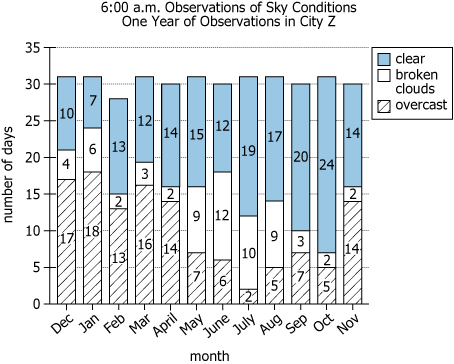The graph shows daily 6:00 a.m. observations of sky conditions in City Z for one year, arranged by month from...
GMAT Graphics Interpretation : (GI) Questions

The graph shows daily 6:00 a.m. observations of sky conditions in City Z for one year, arranged by month from December through November.
Select from each drop-down menu the option that creates the most accurate statement based on the information provided.
Owning the Dataset
Table 1: Text Analysis
| Text Component | Literal Content | Simple Interpretation |
|---|---|---|
| Subject Matter | observations of sky conditions | Tracking weather/cloud cover |
| Location | City Z | The data is from a single, specific city |
| Observation Method | daily 6:00 a.m. observations | Measurements taken every day at dawn |
| Time Span | for one year | Data spans 12 consecutive months |
| Organization | arranged by month from December through November | Data grouped into months, starting in December |
Table 2: Chart Analysis
| Chart Component | Shown In Chart | Interpretation |
|---|---|---|
| Chart Type | Stacked bar chart, 3 colored segments per month | Compares three types of sky conditions each month |
| X-axis | Months: December through November | Complete annual cycle, starting in winter |
| Y-axis | Number of days (0-35) | Each bar height gives number of days in the month |
| Categories | Clear, broken clouds, overcast | Every observed day is classified into one of these |
| Patterns | Winter/spring: mostly overcast/broken clouds; Summer/autumn: clear dominates |
Shows strong seasonal trends: cloudy winters/springs, clear summers/autumns |
| Data Extremes | October: 24 clear days (most); February/April/November: 2 clear days (fewest) |
Demonstrates dramatic month-to-month variation in cloudiness |
Key Insights
October has the highest number of clear days (24), while February, April, and November have the fewest (2 each). No month shows an equal number of clear and overcast days—February comes closest (2 clear vs. 13 overcast). A clear seasonal pattern is visible: winter and spring months are mostly cloudy, while late summer and autumn are predominantly clear. Note: all observations occur at 6:00 a.m., so the dataset shows only early morning sky conditions, not the entire day's weather.
Step-by-Step Solution
Question 1: Finding the First Month with Same Number of Clear Days as February
Complete Statement:
The number of clear days equals the number of overcast days in February, [BLANK 1], and [BLANK 2].
Breaking Down the Statement
Statement Breakdown 1:
- Key Phrase: number of clear days equals the number of overcast days
- Meaning: We are being asked to identify months where the count of clear days is equal to the count of overcast days.
- Relation to Chart: Compare the number of clear days (often the bottom row or segment in the chart/table) to the overcast days (top row or segment) for each month.
- Important Implications: It's necessary to check whether February itself has equal clear and overcast days, as claimed.
Statement Breakdown 2:
- Key Phrase: in February, [BLANK 1], and [BLANK 2]
- Meaning: We need two more months, from separate lists, that share this property with February.
- Relation to Chart: We need to look at February's actual numbers and find matching numbers in the answer choices.
- Important Implications: Closer examination often reveals February does NOT have equal clear and overcast days. If that's the case, we must interpret the question as asking for months with the same number of clear days as February.
What is needed: A month from the first list whose number of clear days is the same as February.
Solution:
- Condensed Solution Implementation: Check February's number of clear days, then check each month in the first answer list for a match.
- Necessary Data points: February has 2 clear days. The options are: January (6), March (3), April (2), May (12), June (12) clear days.
- Calculations Estimations: April has 2 clear days, which matches February's value.
- Comparison to Answer Choices: April is the only option from the first list that matches February's clear day count.
FINAL ANSWER Blank 1: April
Question 2: Finding the Second Month with Same Number of Clear Days as February
Complete Statement:
The number of clear days equals the number of overcast days in February, April, and [BLANK 2].
Breaking Down the Statement
Statement Breakdown 1:
- Key Phrase: in February, April, and [BLANK 2]
- Meaning: We are looking for a third month with the same number of clear days as February and April.
- Relation to Chart: Refer to the number of clear days in the relevant months and check answer choices from the second list.
What is needed: A month from the second list whose number of clear days is the same as February and April (2 clear days).
Solution:
- Condensed Solution Implementation: Review each month in the second answer list and check if any has 2 clear days.
- Necessary Data points: Second list options: July (19 clear), August (17 clear), October (24 clear), November (2 clear), December (4 clear).
- Calculations Estimations: November is the only month among the choices with 2 clear days.
- Comparison to Answer Choices: Only November matches the desired value from the second list.
FINAL ANSWER Blank 2: November
Summary
Since February does not have equal numbers of clear and overcast days, the question truly asks for other months with the same number of clear days as February (2 days). By inspecting the provided answer choices, April and November are the only months from each list with exactly 2 clear days. Thus, the blanks are filled by April and November respectively.
Question Independence Analysis
These questions are dependent because identifying that 'clear days' are the true criterion in the first blank directly informs how we should approach the second blank; both must match February's number of clear days.